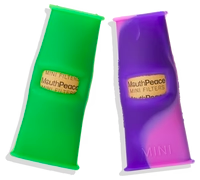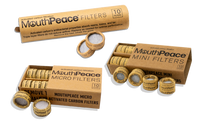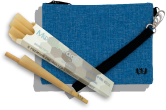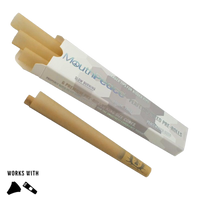
Did you just buy some cannabis and suspect it might be contaminated with mold? Or maybe you’ve stored your stash for a while and want to make sure it’s still good before smoking.
Smoking moldy weed is not only unpleasant but also unsafe, and that’s why knowing how to spot it in the first place is crucial.
In this article, we’ll show you how to identify moldy weed, explain the risks, and share tips for keeping your stash fresh and safe in the future. Let’s dive in!
WHAT IS MOLDY WEED?
Moldy weed is exactly what it sounds like—Cannabis that has been contaminated with mold. Mold is a type of fungus that’s pretty much everywhere. You’ll find it on expired bread or creeping up bathroom tiles.
Given the right conditions, such as high humidity, poor air circulation, and warm temperatures, weed can also become a victim of mold.
The most common types of mold that affect weed are:
-
Aspergillus: This type loves warm, humid spots. It’s hard to spot but can be harmful if inhaled.
-
Botrytis (Bud Rot):This is the one that causes bud rot. It turns your buds into a mushy gray mess.
-
Powdery Mildew: This white powdery fungus covers leaves and buds and looks like a dusting of flour.
These fungi can make your stash a health hazard when they take hold. They also ruin your weed, reducing its potency, flavor, and overall appeal.
SIGNS OF MOLDY WEED

So, how can you know if your weed or cannabis plant has mold? Here are several telltale signs of mold to watch out for:
VISUAL INDICATORS
One of the most obvious ways to spot moldy weed is by looking at it. Keep an eye out for:
-
Fuzzy white or gray stuff: Mold resembles a fuzz, powdery coating on the buds or leaves, like a spider web or cotton balls. This can be white, gray, green, or black.
-
Unusual colors:Normal weed should be vibrant green with hues of purple, orange, or red, depending on the strain. If you see any unusual colors, like brown or yellow patches, it could be mold or bud rot.
-
Visible spores:Some molds, like Aspergillus, produce visible spores that look like tiny black or green dots on the buds.
Now, take note not to confuse mold for trichomes or vice versa. Trichomes are tiny hairs that carry cannabinoids like THC and terpenes of cannabis. They cover your buds and give them a frosty appearance. So, how can you tell them apart from mold? Trichomes have a glistering crystalline appearance, while mold is a dull, fuzzy coating that doesn’t sparkle.
TEXTURE CHANGES
The next way to know if your weed is moldy is to feel its texture. It is a red flag if it feels slimy, mushy, or damp. That’s a big sign your stash has mold. Healthy buds should be dry and crisp.
On the flip side, watch out for extremely dry buds that feel crumbly or powdery and disintegrate into dust when you touch them. This can also be a sign of moldy weed.
SMELL INDICATORS
Your nose might catch mold before your eyes do. Unlike regular weed, which has a pungent, earthy, or sweet smell depending on the strain, moldy weed has a distinct smell that’s hard to miss.
Moldy weed smells musty, like wet cardboard or hay. You might also pick up notes of mildew or a general “off” smell that doesn’t match the usual weed smell you’re used to. If you take a whiff and catch any of these smells, it’s best to render your weed unsafe to consume.
WHAT CAUSES MOLDY WEED?
IMPROPER STORAGE CONDITIONS
High humidity, lack of air circulation, and warm temperatures are mold’s best friends. If you’re storing your weed in a damp, warm place with no airflow, you’re inviting mold over for dinner.
POOR CULTIVATION PRACTICES
If growers don’t properly dry and cure the buds, mold can grow before they reach you. That’s why buying from reputable dispensaries or trusted sources is super important.
CAN YOU SMOKE MOLDY WEED?

No, pleaseee don’t do it!!
Smoking moldy weed is not recommended. Plus, it won’t taste good anyway.
But why exactly is it so bad? Well, when you light up, you’re not just burning the weed—you’re also burning the mold. This releases mold spores into the air, which you then inhale directly into your lungs. This can cause respiratory issues and allergic reactions, which we’ll go into more detail in the next section, so keep reading.
HEALTH RISKS OF SMOKING MOLDY WEED
So, coming back to the potential health issues that come with smoking moldy weed, let’s explore the most common and why it’s a bad idea:
-
Respiratory issues:Smoking moldy weed can irritate your lungs and airways, making it hard to catch your breath. Think coughing, wheezing, and difficulty breathing.
-
Allergic reactions:Some people are more sensitive to mold than others and might experience allergy-like symptoms. These include Itchy eyes, runny nose, and even sinus pain.
-
Long-term problems: For folks with weakened immune systems, some types of mold, like Aspergillus, can cause severe lung infections, such as aspergillosis. Dun, Dun, Dun...This is a potentially life-threatening condition that can spread from the lungs to other parts of the body.
-
Headaches and nausea: Even if you don’t have a full-blown allergic reaction, moldy weed can still make you feel pretty crummy.
HOW TO PREVENT MOLD FROM GROWING ON YOUR WEED

Is there a secret to keeping your weed mold-free? It all comes down to proper storage. Here are some storage tips for you:
AVOID REFRIGERATOR OR FREEZER
Your buddies might have told you to store your weed in the freezer or refrigerator, but that’s not a great idea. These environments are damp, and when you take your cannabis out, it can quickly attract moisture from the air. This excess moisture is basically an open invitation for mold growth.
CONTROL HUMIDITY AND TEMPERATURE
Aim for 59-63% relative humidity and 60-70°F (15-21°C). That’s the sweet spot where your buds won’t dry out or get too moist. The ideal temperature range prevents both drying and moisture build-up.
ENSURE GOOD AIR CIRCULATION
Stagnant air is mold’s best friend. Make sure your storage spot has good air circulation. Good airflow helps maintain consistent humidity and temperature and reduces the risk of mold growth.
STORE IN AIRTIGHT CONTAINERS IN A DRY PLACE
Keep your weed safe by storing it in glass jars with tight lids. Mason jars work perfectly, but some dispensaries sell containers specifically for weed. Make sure whatever you use is clean and dry before putting your stash in.
Now, find a cool, dry spot for your container. A dark closet or drawer is perfect. Avoid direct sunlight and damp areas—those can encourage mold growth. When you open that jar weeks later, your weed will be mold-free; you’ll be glad you took these steps to protect it.
WHAT TO DO IF YOU FIND MONLY WEED?
Oh no, you found out, and your weed is already moldy. What do you do now? You might be tempted to cut or scrape off the moldy parts, but that’s not a good idea. Mold can spread throughout the entire cannabis bud even if you can’t see it.
HERE’S WHAT TO DO:
-
Isolate the affected cannabis: Keep the moldy weed away from your clean stash. Mold spores are sneaky and can spread fast.
-
Document and report:If you got it from a dispensary, take clear pics and let them know. This helps prevent others from getting moldy products and might get you a refund.
-
Dispose of it safely:Seal the moldy weed in a plastic bag before throwing it out. This stops mold spores from spreading.
-
Clean everything:Wash any containers or tools that touched the moldy weed with hot, soapy water. Mold spores can stick around, so be thorough.
-
Review your storage: Figure out what went wrong. Was it too humid? Not airtight enough? Learn from this so you can prevent future mold issues.
4 TIPS FOR AVOIDING MOLDY WEED IN THE FUTURE
-
Buy from reputable sources: Licensed dispensaries are required to test their cannabis products for mold and other contaminants.
-
Check the packaging date: Fresher is usually better when avoiding mold.
-
Inspect before you buy: If possible, look closely at the weed before purchasing it. Most dispensaries let you see and smell the product.
-
Ask questions: Don’t be shy about asking the budtender about their quality control processes.
BOTTOM LINE: HOW TO SPOT MOLDY WEED
To conclude, Moldy cannabis usually looks, smells, or tastes off. Always give your stash a quick check before you light up. This simple habit can save you a lot of trouble.
Now, one last thing to consider: Sometimes, even if you’re careful, you might miss moldy weed, especially if it’s just starting to form. As you’ve seen, smoking moldy weed can cause serious health issues like breathing problems, allergic reactions, and potential lung issues.
The best way to stay safe when smoking weed is to use an advanced weed filter like those from MooseLabs. These filters can catch harmful stuff like mold spores before they reach your lungs. Remember, this is not an invitation to smoke moldy weed but a precautionary step for when mold might slip past your inspection.
FAQ:
What Does Moldy Weed Look Like?
Moldy weed often appears fuzzy or powdery, with white, gray, or greenish spots. It might also have dark or discolored patches.
Can Mold Go Away On Weed?
No, mold will not go away on weed once it’s grown. The mold will continue to spread and contaminate more of the weed over time. If you see any mold, remove the affected weed immediately.
Is Moldy Weed Edible?
No, moldy weed is not edible!! Eating mold spores Is harmful.
Is It Bad To Smoke Moldy Marijuana?
Yes, smoking moldy marijuana plants is terrible. It can cause various health problems ranging from respiratory issues to allergic reactions and even lung infections in extreme cases.
What Happens If You Smoke Moldy Weed?
Smoking moldy weed can cause coughing, wheezing, shortness of breath, sinus pain, and respiratory system inflammation. In some cases, it can also trigger an allergic reaction or aspergillosis, a lung infection caused by inhaling mold spores.














